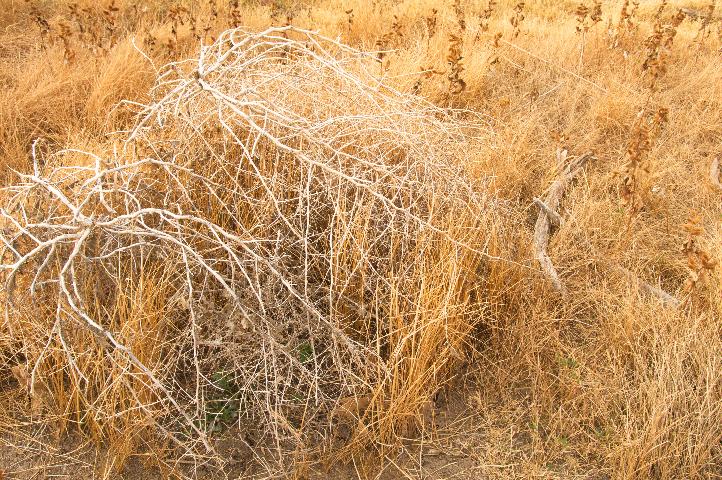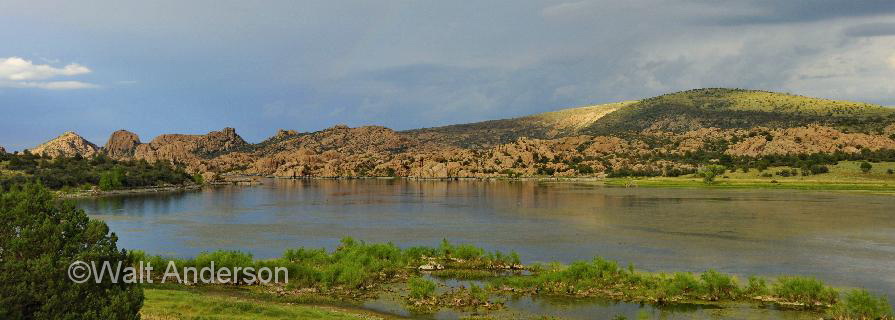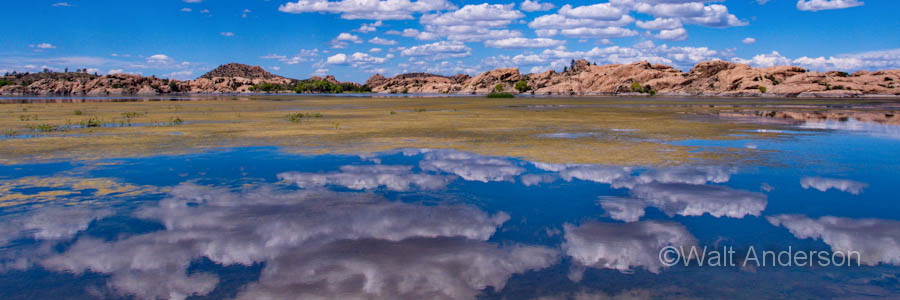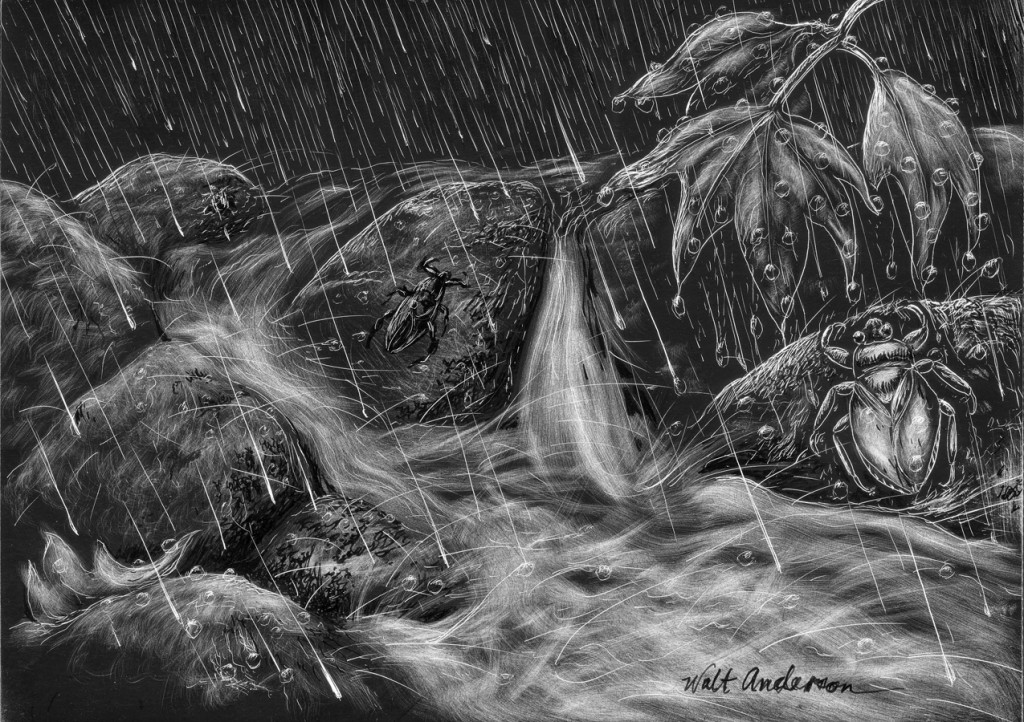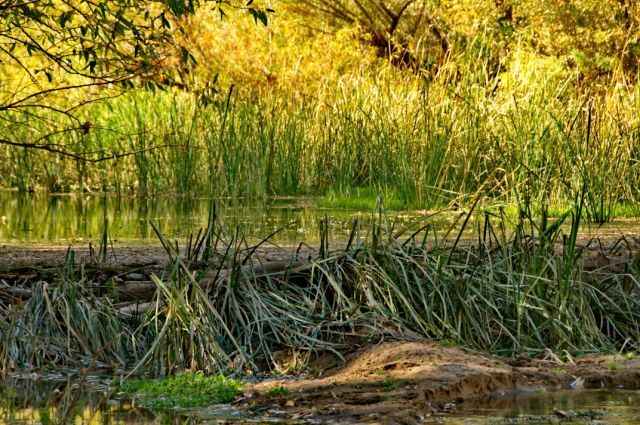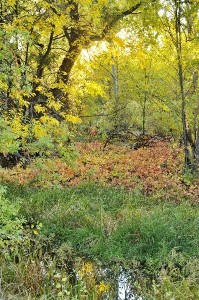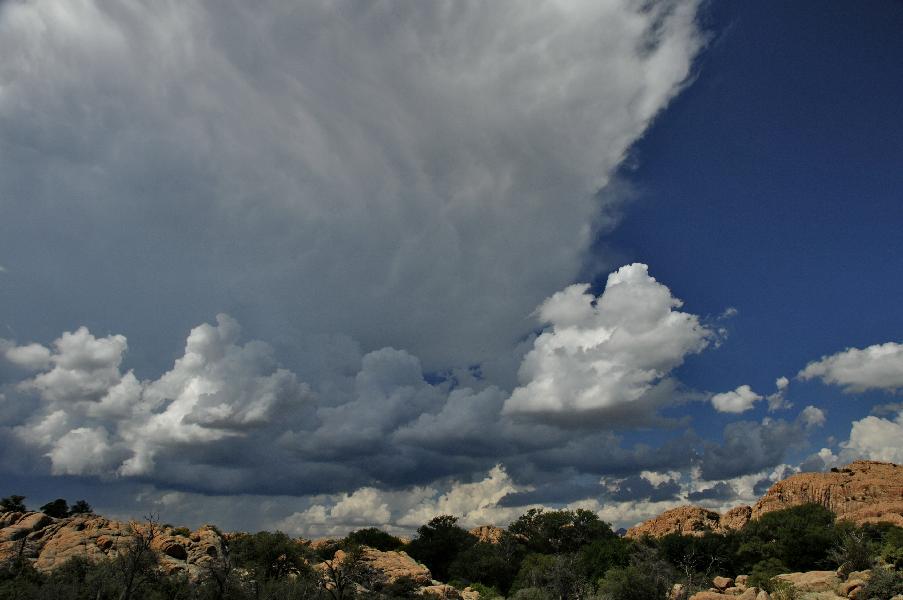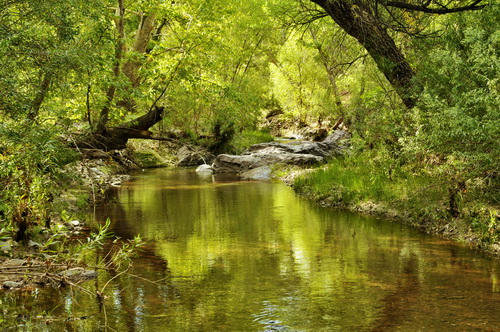Drifting along, like a tumbling tumbleweed. That catchy tune warbled by the Sons of the Pioneers somehow epitomizes nostalgia for the Old West. Never mind that the tumbleweed is a carpetbagger, an interloper, an émigré otherwise known as Russian thistle. I’ve heard tell that the Russkies sent it here as a kind of biological weapon, a plague on our plains, a prickly infestation designed to lay waste to our grasslands, to overwhelm us with its ability to take any of our attacks against it and come back stronger than ever. Where is the real truth here? Continue reading
Tag Archives: Arizona
Granite Dells & the Lakes
Granite Dells and the Lakes—Central to Arizona
In Arizona, a state noted for natural wonders, Yavapai County stands out. Prescott’s physical environment—pine forests, chaparral, pinyon-juniper woodlands, grasslands, dramatic rock formations, and wetlands—is one of the reasons it is called “Everybody’s Hometown.” Watson and Willow Lakes in the Granite Dells dominate this landscape.
For the entire month of June, the Prescott Public Library Viewerie will display more than thirty large (some up to six feet in length) photographs in professional gallery mounts of Granite Dells and the Lakes (Watson & Willow) that stand as the centerpiece of the Tri-city area of Prescott, Prescott Valley, and Chino Valley in Yavapai County, Arizona. They represent the work of Walt Anderson, acclaimed nature photographer, and Joe Phillips, master printer. A reception open to the public is set for Wednesday, June 6, from 5:30-7:30 pm at the library.
This site presents an expanded tour of the content and images, with bonus photos and text added, but it cannot replace the impact of seeing the images in live time. Please try to visit the exhibition. Images are for sale from the photographer (geolobo@cableone.net or 928-445-7470), and other images and sizes, individually and lovingly printed by Joe, can be created for your needs. Here is the price list with images.
This exhibit celebrates our natural heritage and urges all citizens, including decision-makers, to prioritize protection and wise stewardship of our great natural assets. Right here, right now, in the heart of this watershed, we must act to keep what we love. Continue reading
Where do Toe-biters go when it Rains?
Where Do Toe-biters Go When It Rains?
- Floodbug
Curiosity is a well-known field mark of a naturalist, and I have learned to indulge my curiosity when an opportunity arises. Some years ago, I stayed with friends in the Chiricahua Mountains of SE Arizona, one of the dramatic “sky islands” of the Southwest. Back in the cooler, wetter Pleistocene, the forests marched across the valleys, allowing free commerce for animals and plants among the ranges. As conditions warmed and dried, the forests retreated to higher elevations, trapping survivors on habitat islands. Continue reading
I’m a Beaver Believer
So often we hear horror stories of environmental degradation. Once in awhile we need to hear the good news, the reversal of misfortune, and I’m here to tell you one such story. The Upper Verde River in Arizona has risen from its deathbed, and the main reason is the return of the beaver after the removal of the cows. Join me along the banks of Granite Creek as I tell my friend Joe about my impressions of the value of beavers in restoring an ecosystem. http://www.youtube.com/watch?v=kTlSKffiSPw&feature=youtu.be.
When Resignation Means Renewal
A blustery stranger arrived unannounced on Friday. The day dawned clear like so many others. By 11 as I drove home from the college for a quick lunch, the unexpected guest had arrived, leaving the door open so that its forceful breath whipped up whitecaps on Watson Lake. Dust and leaves swirled in its powerful exhalations. Low clouds streamed over the rounded crests of the Bradshaw Mountains. Winter had suddenly returned to Arizona. Continue reading
Deepening the Time Scale: A Puzzle in Sycamore Canyon
Though each organism is inherently a time traveler, its genes a partial chronicle of its evolutionary history, we may be the sole species to be able to reflect on that deeper history. People with deep imaginations can visualize the ape in our behaviors, the prototypical vertebrate in our embryos, the symbiotic merger reflected in our mitochondria. Some can look at a hillside and envision it as a product of tectonic upheavals, erosional incisions and depositions, the lithification that turned sediment into rock that has weathered into a substrate supporting juniper, cactus, and spiny lizard. With some training, there is hope for those of us who don’t normally see so well. Our temporal blinders may be lifted, our spirits uplifted by the joys of discovery and insight. Informed imagination – that greatest of time machines – can take us further toward understanding the Sky Islands than mere physical descriptions ever will. Join me, then, for a little time travel, not to see it all (who has time?), but for a sample of how informed imagination works. Continue reading
I Break for Clouds
Monsoon season in Arizona is a time of waiting and watching. Waiting for rain is like playing the lottery. Your odds improve after the 4th of July, but it’s still a roller coaster of optimism and disappointment.
This morning dawns with haze and humidity, and by 8 am, the sun’s direct rays drill into my shoulders like a laser beam. Decisions—do I water the outside plants or not? For days, the thunderheads have played with us, marching toward Granite Dells like an invading army, rumbling ominously and trailing sheets of rain, only to dissipate upon arrival. They act as if it was all bluster, threat, intimidation, then shrug a rounded shoulder, “Just kidding!” . . . It’s hard not to take it personally. Continue reading
Bats, Cuckoos, and Happiness

Granite Dome at sunset
After a day spent mostly at the computer screen, I need to stretch. Granite Dells stretches me, pulls me irresistibly into the mazes of outcrops and canyons, especially appealing when thunderheads have finished their rumbling and are sailing away across the heavens, mission accomplished.
I head toward Granite Creek, its cottonwoods pulsing with the choruses of strident cicadas. Though monsoon storms have been modest at best in this neighborhood, the weeds, native and otherwise, are dense and lush. Fortunately, mosquito populations here are lower than last year, and as long as I keep moving, I avoid serious blood-letting.
There are signs here indicating that this is a restoration area, and the twenty-foot cottonwoods and shorter velvet ash and hackberry trees are evidence that recovery is occurring. A developer had grand plans for this area, and he drained a small recreational lake that had been used by residents and tourists alike in the “good old days” of early Prescott. He also cut out the willows and cottonwoods that framed the pond and leveled the whole works for his development. There were plans for a bridge across Granite Creek where now there is a fair-weather ford—a bridge that might have impeded Wood Ducks and Black-Hawks as they flew up and downstream searching for food. With money pouring from his deep pockets and machines moving the earth with seeming impunity, he didn’t take one thing into account: his development was right next to the property of one of the Dells’ most colorful characters, Happy Heavenly Oasis (no, this is not a pseudonym). Continue reading
Surprises
Rodeo grounds open space, Prescott, Arizona
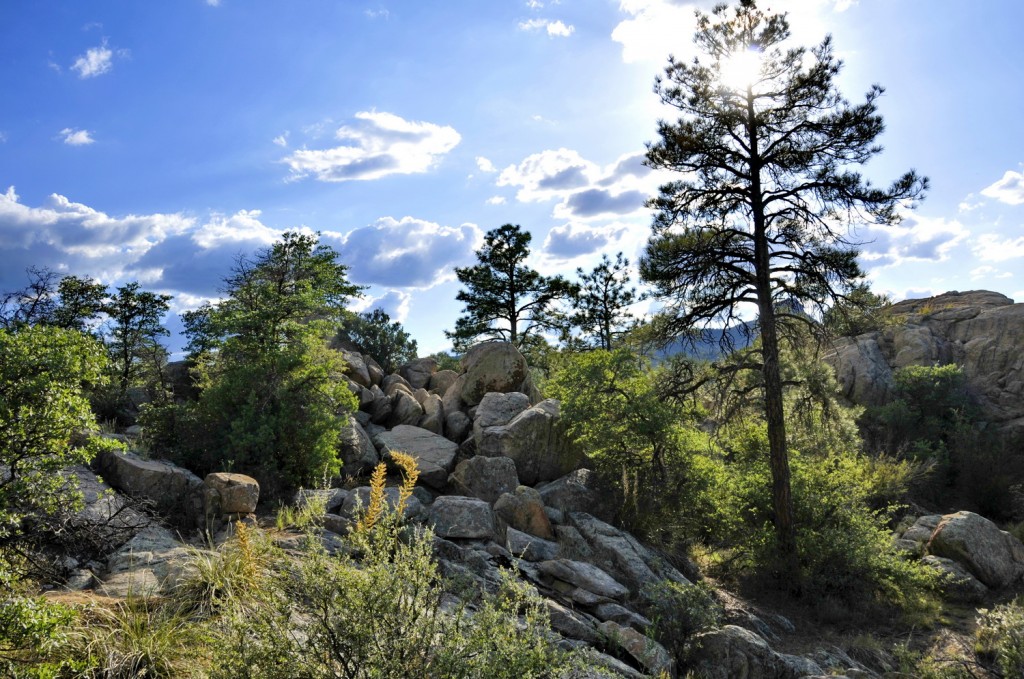
Surprises.
A friend of mine sent me a newspaper clipping and asked “What the heck is going on here?” Entitled “ ‘ Porpoisidal’ Dolphins,” the article quotes some marine mammal researchers who witnessed “violent and fatal” attacks by bottlenose dolphins on harbor porpoises. They were baffled that one marine mammal would attack and kill others not likely to be direct competitors, but they speculated that high levels of testosterone might have been involved.
It’s challenging to evaluate such reports because of our human perspectives. We shake our heads at human gang-rapes and shooting sprees, somewhat comforted that these are aberrations even among humans. We accept the range of human variability without recognizing anything similar among other animals. Then some researchers discover panicidal (murderous) chimps or individual baboons that stalk and kill young antelope. Then there is Fifi, behaving just fine at home but becoming a raging pack animal out to kill when running loose with other “domestic” dogs. These are perhaps the flip side of cases where the lion lies down with the lamb, where the tiger mother raises piglets or the she-wolf raises a feral boy. You can advance hypotheses about the overwhelming strength of maternal instincts or the corrupting influence of testosterone; some may prove true, others not. The interesting thing is that we are surprised. Continue reading
Borderlands Musings
BORDERLANDS MUSINGS
By Walt Anderson
Four decades ago, I was a grad student in the School of Natural Resources at the University of Arizona in Tucson. Well before Arizona gained its strong reputation as a hotspot for American birding, there was a small community of birders who sought out the neotropical specialties that crossed the border and the eastern vagrants that popped up now and then in desert oases. There were seasoned experts like Gale Monson, whose knowledge of Southwest birds was encyclopedic, and ragtag graduate students like Carroll Littlefield, an expert on Sandhill Cranes, and Ted Parker, later considered by many as the superstar of birders and field ornithologists. There was none of the competitive, obsessive listing that later infected the birding world, a narrow-minded focus on seeing and ticking off species as fast as possible, the interest in each bird satisfied by a mere checkmark. No, these were naturalist birders, keen observers who sought to learn about the entire ecosystems in which birds were a part. Where a bird nested, what it ate, how it migrated or molted—such were the questions that occupied the curiosities of this generation of field biologists.
Whenever possible, we would load up a tank of gas at twenty-some cents per gallon and take off to one of our favorite oases, ostensibly to bird, but even more so to explore wild places and experience the joys of discovery in nature. Often our paths took us through the dusty border town of Douglas, Arizona under the appalling smokestacks of Phelps Dodge, then likely the largest single point-source of pollution in the Southwest, if not America as a whole. Continuing east along teeth-chattering gravel roads, we passed through the “malpai” badlands of rocky hills, creosote bush, ocotillo, and occasional flash-flood-prone desert washes. We’d pass the old ranch of Texas John Slaughter, where we’d stop to glass for whistling ducks, Neotropic Cormorants, Vermilion Flycatchers, and other oasis birds drawn to the artesian springs there (later much of this became the San Bernardino National Wildlife Refuge established primarily to help save native fishes of the Rio Yaqui watershed).
Our final destination lay at the end of the road just into New Mexico right where that state intersects with Arizona and Sonora: a green finger of Mexican riparian woodland, Guadalupe Canyon. We would stop up at the Magoffin ranch house to pay our respects and get their generous permission; then we’d explore the main canyon of large cottonwoods and sycamores and venture up thorny side washes for arid-adapted specialties. At night, we would listen and watch for the Ridgeway’s Whip-poor-will (now called Buff-collared Nightjar), one of the species that barely entered the United States at this point.
We were certainly aware of the proximity of Mexico, but only because we could count birds seen on this side of the weak barbed-wire fence for our U.S. list. At night as we lay in sleeping bags under the canopy of trees and the overarching dome of stars in an unpolluted sky, we might awaken to the footsteps and breathing of men, usually alone or with one companion, heading north to work, seeking employment opportunities that were unavailable south of the border. We might meet them at dusk or in early morning, where a polite exchange of “Buenos Dias” or “Hola” along with shy smiles would be the extent of our interchange. Continue reading

